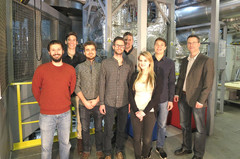
Without fossil fuels, there can be no blast furnace process – but hydrogen could play a more important role in the future. An environmentally friendly process is being developed at TU Wien by which biomass can be used to produce a hydrogen-rich gas that can then be employed in various ways in the iron and steel industry. TU Wien and voestalpine now aim to conduct further joint research on the subject. The long-term vision is a renewable energy source, firmly anchored in the design of an integrated iron and steel works.
Two gas streams: hydrogen here, carbon dioxide there
In a process developed at TU Wien, biomass is converted at high temperatures in a way that produces two separate gas streams: a hydrogen-rich producer gas and a CO2-rich waste gas. This is known as a biomass reforming process and is made possible by the use of lime in a special fluidised bed system. In an integrated steel works combining the many production and finishing steps from pig iron to the finished steel product, it would be possible to use the hydrogen-rich production gas at various production stages. As a renewable energy source, this would offer an environmentally friendly alternative to natural gas. At the same time, research is also being carried out on the waste gas stream. Under the new process, the CO2 that it contains is enriched and can thus be efficiently separated out or subjected to further processing.
“From a chemical point of view, the important reactive step in the blast furnace process is the reduction of the iron ore,” explains Johannes Schmid, Project Manager at TU Wien’s Institute of Chemical Engineering. “In the natural ore, iron is present in the form of iron oxide, so the oxygen atoms first need to be separated from the iron atoms.”
In this reduction process, the carbon in the coke, and in particular the resulting carbon monoxide, plays a key role. Up to a certain proportion, however, hydrogen can also serve as a possible reducing agent. The whole process chain, from the production and integration of hydrogen gas from renewable sources to its use in blast furnaces, will require further research in the future. “At any rate we can show that a reductant gas can be obtained from biomass with the aid of a new process,” explain Florian Benedikt, Josef Fuchs and Stefan Müller, who are working on the project. “According to our measurements, in principle our production gas is a suitable additional biogenous energy source. The gas quality is at least equivalent to that which voestalpine is already using today for various processing stages in an integrated iron and steel works.”
Carbon dioxide exploitation: even better than CO2-neutral
The second gas flow produced in TU Wien’s biomass reforming process contains CO2. If the carbon dioxide is ultimately released into the environment, this closes the carbon cycle: all that is released is the CO2 that was previously stored as biomass in the plants that have been used. If the CO2 is not released into the environment but processed further, then the process has an even better CO2 footprint: This is known as a ‘below-zero emission’ process.
Vision: implementation of renewable energy sources in production processes
Prof. Hermann Hofbauer is delighted with the results that have been achieved: “The implementation of renewable energy sources in a resource-intensive process such as steel production presents a major challenge. The research project with voestalpine on this subject is therefore an important lighthouse project for our research group.” To optimise the biomass reforming process, a large research facility, with a total height of seven metres, was constructed between 2013 and 2015 at TU Wien. “Only such a facility can give us the meaningful results that will allow us to design major industrial demonstration installations,” says Hofbauer.

“Our results are showing us that it is technically possible,” explains Johannes Schmid. “For high-quality biomass such as wood chips, though, it is not possible to illustrate economically the prospects for use under current conditions. That’s why further intensive research is necessary, so that we can also make it possible to use inexpensive biogenous raw materials.” In addition to hydrogen generation using an electrolysis process, the technology also offers another possible green alternative for steel production in the long term.
Further information
Project Group: Gasification and Gas Cleaning
Contact
Dr. Johannes Schmid
Inst. for Chemical Engineering
TU Wien
T: +43-1-58801-166385
M: johannes.schmid@tuwien.ac.at
Source
TU Wien, press release, 2017-06-21.
Supplier
Technische Universität Wien (TU Wien)
voestalpine
Share
Renewable Carbon News – Daily Newsletter
Subscribe to our daily email newsletter – the world's leading newsletter on renewable materials and chemicals













